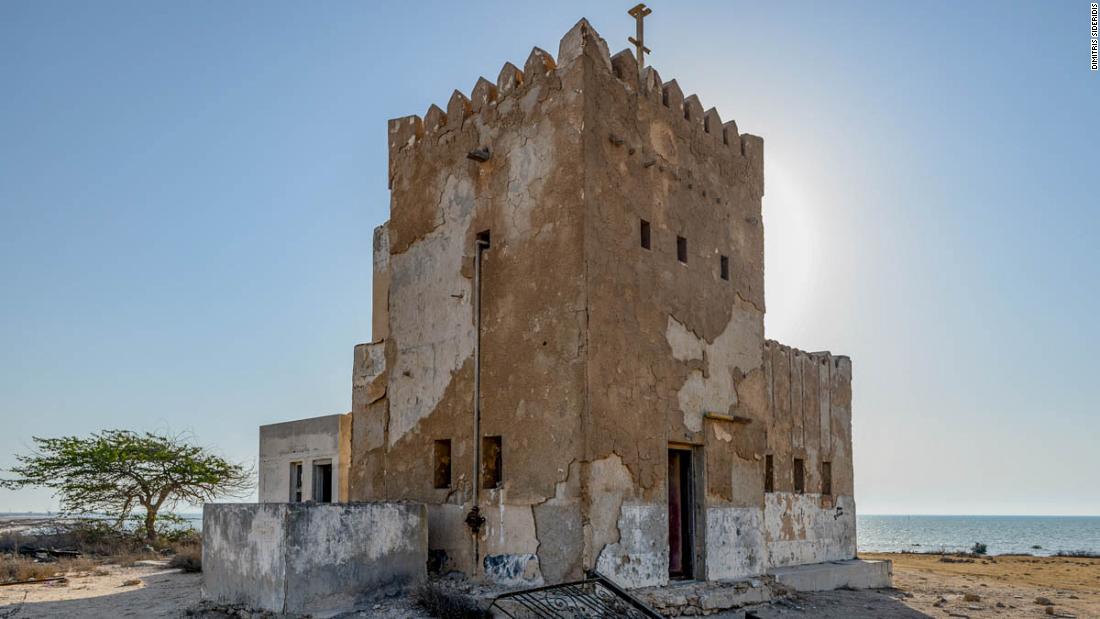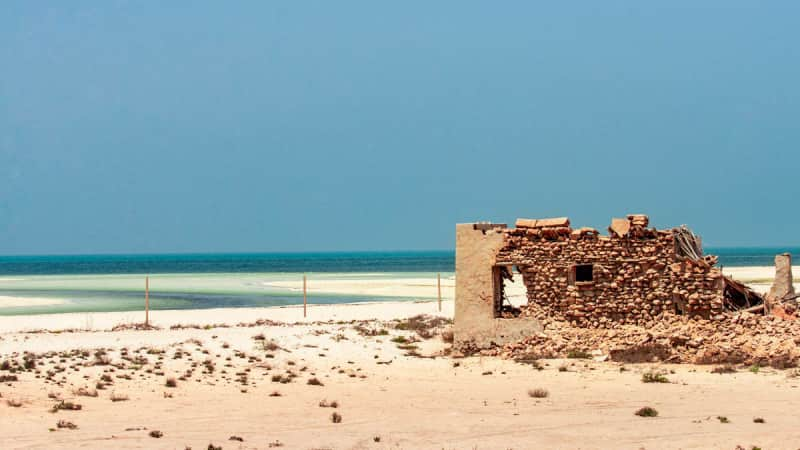Doha (CNN) — Past the small arched door, a narrow spiral stair leads up to the top of the windswept minaret, still standing tall even as almost everything around it has crumbled.
Inside the tiny room atop the circular shaft, four little windows open up to the long-abandoned surroundings. On the one side, the tumbling ruins of old fishermen’s houses — most without a roof, doors or windows — stretch along the turquoise coastline. On the other, the Qatari desert.
This is Al Jumail, one of several forsaken villages dotting the northwest coast of Qatar. The remnants of these little-known “ghost towns” offer a fascinating glimpse of life in ages past, before Qatar’s spectacular oil- and gas-fueled economic boom began pulling people away from its small, traditional villages and into its expanding modern capital of Doha.
While not much is known about its origins, Al Jumail dates back to the second half of the 19th century, according to Qatar Museums. The extensive remains of houses and other buildings point to the significance of the village, one of the oldest settlements in the area that remained populated well into the previous century.
Fishing and pearl diving
The majority of the economic activity of Al Jumail’s inhabitants, as well as of those in other entirely abandoned villages nearby, was anchored to the sea.
“These are fishing villages, which is why the houses are built just above the high tide line,” Ronald William Hawker, an expert on Gulf architecture, tells CNN.
“The intertidal flats in front of the villages are filled with fish traps which would catch the fish when the tide goes out. The surrounding waters were shallow, so they likely used smaller boats that could navigate through the shallow waters and around the various reefs, rocks and rip tides,” he adds.
Most people in the Gulf had several key seasonal ways of earning a living, with pearl diving — one of Qatar’s major revenue streams before the discovery of oil in the 1930s — taking place during the four months of summer.
“Their lives were all about the sea,” Jumaan Basheer Al Hamad is seen saying in a video displayed at the impressive, newly built National Museum of Qatar, part of a series of clips featuring elderly Qataris documenting aspects of the country’s history.
“We started work from the first star of the morning until the maghreb prayer (sunset),” recalls Ahmed Mohammed Srour.
“We never rested or napped. There was no breakfast, or even lunch. The one meal was at dinner time” — usually rice and fish, if the latter was available.
Organic community design

Many of the town’s inhabitants would leave for desert encampments during the winter.
Dimitris Sideridis
67At the time, most residents of coastal towns would move to the Qatari desert during the winter, setting up camp with their animals in various oases across the peninsula. In the summertime, they would return to their houses by the water along the west, north and east shorelines, in villages such as Al Arish, Al Khuwayr, Al Ghariyah and Al Mafjar, to name a few.
The layout and organizational principles of these towns and villages were largely guided by the environment and Islamic traditions, with mosques playing a central role.
In Al Jumail, most living spaces were courtyard houses and oriented inwardly. They had relatively high walls and staggered entrances, aimed at blocking visual access to the inner courtyard and private family spaces. Meals were cooked on wood fires, with people’s diet consisting mainly of rice and fish while dates were used as a substitute for sugar.
“People clustered together according to their extended family,” says Hawker. “[They] weren’t allowed to build in such a way that they could see into their neighbors’ courtyards. This gives the overall community design a more organic layout in comparison with the grid systems preferred by Western architects.”
The construction of these northwestern coastal settlements shows multiple phases and includes techniques that both predate and follow the era of oil concessions. The older building methods combine a beach-rock or coral core with a lime-based plaster for the walls.
“Both are typical of the region,” says Hawker, noting that Al Jumail has also been altered over the years by its periodic use as a film set.
“These [villages] are the last gasp of an old building system before life revolved completely around the oil and gas industries and embody Islamic law and its conception of the physical arrangement of society,” he adds.
Free to access, the ruins of Al Jumail and its surrounding villages are clearly indicated with signs on the main road leading to Al Zubarah, Qatar’s only UNESCO World Heritage Site and one of the most important pearling and trading hubs of the region in the 18th century.
While it is possible to visit them on a standard car, using a four-wheel vehicle is advised for the few kilometers off-road.

